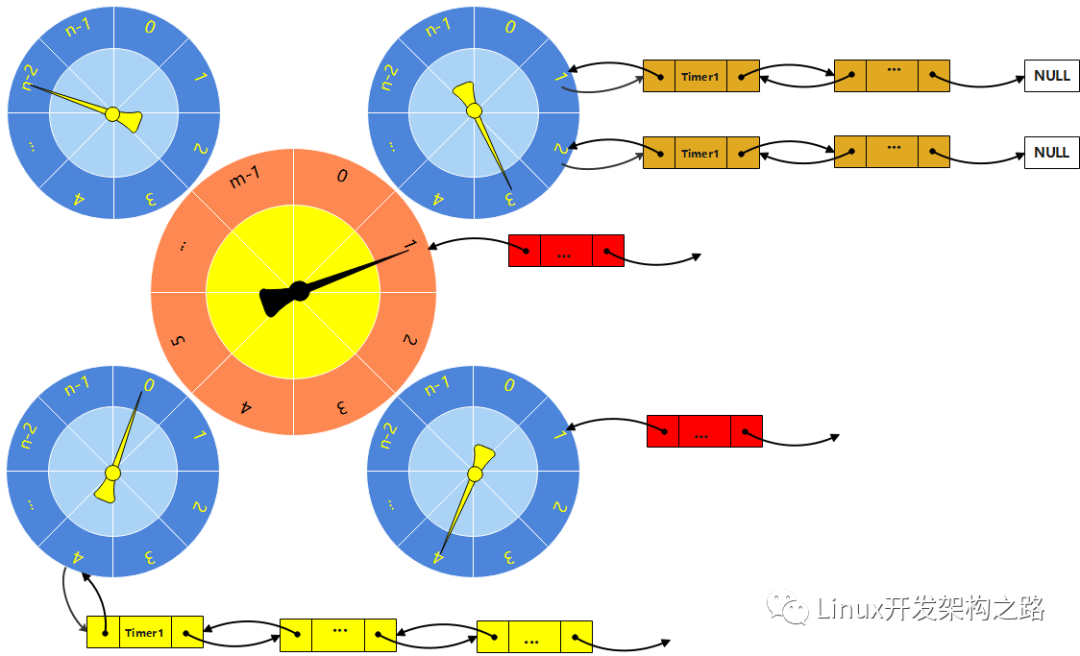

多级时间轮实现框架
描述
一. 多级时间轮实现框架

上图是5个时间轮级联的效果图。中间的大轮是工作轮,只有在它上的任务才会被执行;其他轮上的任务时间到后迁移到下一级轮上,他们最终都会迁移到工作轮上而被调度执行。
多级时间轮的原理也容易理解:就拿时钟做说明,秒针转动一圈分针转动一格;分针转动一圈时针转动一格;同理时间轮也是如此:当低级轮转动一圈时,高一级轮转动一格,同时会将高一级轮上的任务重新分配到低级轮上。从而实现了多级轮级联的效果。
1.1 多级时间轮对象

多级时间轮应该至少包括以下内容:
- 每一级时间轮对象
- 轮子上指针的位置
关于轮子上指针的位置有一个比较巧妙的办法:那就是位运算。比如定义一个无符号整型的数:

通过获取当前的系统时间便可以通过位操作转换为时间轮上的时间,通过与实际时间轮上的时间作比较,从而确定时间轮要前进调度的时间,进而操作对应时间轮槽位对应的任务。
为什么至少需要这两个成员呢?
- 定义多级时间轮,首先需要明确的便是级联的层数,也就是说需要确定有几个时间轮。
- 轮子上指针位置,就是当前时间轮运行到的位置,它与真实时间的差便是后续时间轮需要调度执行,它们的差值是时间轮运作起来的驱动力。
多级时间轮对象的定义
//实现5级时间轮 范围为0~ (2^8 * 2^6 * 2^6 * 2^6 *2^6)=2^32
struct tvec_base
{
unsigned long current_index;
pthread_t thincrejiffies;
pthread_t threadID;
struct tvec_root tv1; /*第一个轮*/
struct tvec tv2; /*第二个轮*/
struct tvec tv3; /*第三个轮*/
struct tvec tv4; /*第四个轮*/
struct tvec tv5; /*第五个轮*/
};
1.2 时间轮对象

我们知道每一个轮子实际上都是一个哈希表,上面我们只是实例化了五个轮子的对象,但是五个轮子具体包含什么,有几个槽位等等没有明确(即struct tvec和struct tvec_root)。
#define TVN_BITS 6
#define TVR_BITS 8
#define TVN_SIZE (1<
此外,每一个时间轮都是哈希表,因此它的类型应该至少包含两个指针域来实现双向链表的功能。这里我们为了方便使用通用的struct list_head的双向链表结构。
1.3 定时任务对象

定时器的主要工作是为了在未来的特定时间完成某项任务,而这个任务经常包含以下内容:
- 任务的处理逻辑(回调函数)
- 任务的参数
- 双向链表节点
- 到时时间
定时任务对象的定义
typedef void (*timeouthandle)(unsigned long );
struct timer_list{
struct list_head entry; //将时间连接成链表
unsigned long expires; //超时时间
void (*function)(unsigned long); //超时后的处理函数
unsigned long data; //处理函数的参数
struct tvec_base *base; //指向时间轮
};
在时间轮上的效果图:

1.4 双向链表
在时间轮上我们采用双向链表的数据类型。采用双向链表的除了操作上比单链表复杂,多占一个指针域外没有其他不可接收的问题。而多占一个指针域在今天大内存的时代明显不是什么问题。至于双向链表操作的复杂性,我们可以通过使用通用的struct list结构来解决,因为双向链表有众多的标准操作函数,我们可以通过直接引用list.h头文件来使用他们提供的接口。
struct list可以说是一个万能的双向链表操作框架,我们只需要在自定义的结构中定义一个struct list对象即可使用它的标准操作接口。同时它还提供了一个类似container_of的接口,在应用层一般叫做list_entry,因此我们可以很方便的通过struct list成员找到自定义的结构体的起始地址。
关于应用层的log.h, 我将在下面的代码中附上该文件。如果需要内核层的实现,可以直接从linux源码中获取。
1.5 联结方式
多级时间轮效果图:

二. 多级时间轮C语言实现
2.1 双向链表头文件: list.h
提到双向链表,很多的源码工程中都会实现一系列的统一的双向链表操作函数。它们为双向链表封装了统计的接口,使用者只需要在自定义的结构中添加一个struct list_head结构,然后调用它们提供的接口,便可以完成双向链表的所有操作。这些操作一般都在list.h的头文件中实现。Linux源码中也有实现(内核态的实现)。他们实现的方式基本完全一样,只是实现的接口数量和功能上稍有差别。可以说这个list.h文件是学习操作双向链表的不二选择,它几乎实现了所有的操作:增、删、改、查、遍历、替换、清空等等。这里我拼凑了一个源码中的log.h函数,终于凑够了多级时间轮中使用到的接口。

#if !defined(_BLKID_LIST_H) && !defined(LIST_HEAD)
#define _BLKID_LIST_H
#ifdef __cplusplus
extern "C" {
#endif
/*
* Simple doubly linked list implementation.
*
* Some of the internal functions ("__xxx") are useful when
* manipulating whole lists rather than single entries, as
* sometimes we already know the next/prev entries and we can
* generate better code by using them directly rather than
* using the generic single-entry routines.
*/
struct list_head {
struct list_head *next, *prev;
};
#define LIST_HEAD_INIT(name) { &(name), &(name) }
#define LIST_HEAD(name)
struct list_head name = LIST_HEAD_INIT(name)
#define INIT_LIST_HEAD(ptr) do {
(ptr)- >next = (ptr); (ptr)- >prev = (ptr);
} while (0)
static inline void
__list_add(struct list_head *entry,
struct list_head *prev, struct list_head *next)
{
next- >prev = entry;
entry- >next = next;
entry- >prev = prev;
prev- >next = entry;
}
/**
* Insert a new element after the given list head. The new element does not
* need to be initialised as empty list.
* The list changes from:
* head → some element → ...
* to
* head → new element → older element → ...
*
* Example:
* struct foo *newfoo = malloc(...);
* list_add(&newfoo- >entry, &bar- >list_of_foos);
*
* @param entry The new element to prepend to the list.
* @param head The existing list.
*/
static inline void
list_add(struct list_head *entry, struct list_head *head)
{
__list_add(entry, head, head- >next);
}
/**
* Append a new element to the end of the list given with this list head.
*
* The list changes from:
* head → some element → ... → lastelement
* to
* head → some element → ... → lastelement → new element
*
* Example:
* struct foo *newfoo = malloc(...);
* list_add_tail(&newfoo- >entry, &bar- >list_of_foos);
*
* @param entry The new element to prepend to the list.
* @param head The existing list.
*/
static inline void
list_add_tail(struct list_head *entry, struct list_head *head)
{
__list_add(entry, head- >prev, head);
}
static inline void
__list_del(struct list_head *prev, struct list_head *next)
{
next- >prev = prev;
prev- >next = next;
}
/**
* Remove the element from the list it is in. Using this function will reset
* the pointers to/from this element so it is removed from the list. It does
* NOT free the element itself or manipulate it otherwise.
*
* Using list_del on a pure list head (like in the example at the top of
* this file) will NOT remove the first element from
* the list but rather reset the list as empty list.
*
* Example:
* list_del(&foo- >entry);
*
* @param entry The element to remove.
*/
static inline void
list_del(struct list_head *entry)
{
__list_del(entry- >prev, entry- >next);
}
static inline void
list_del_init(struct list_head *entry)
{
__list_del(entry- >prev, entry- >next);
INIT_LIST_HEAD(entry);
}
static inline void list_move_tail(struct list_head *list,
struct list_head *head)
{
__list_del(list- >prev, list- >next);
list_add_tail(list, head);
}
/**
* Check if the list is empty.
*
* Example:
* list_empty(&bar- >list_of_foos);
*
* @return True if the list contains one or more elements or False otherwise.
*/
static inline int
list_empty(struct list_head *head)
{
return head- >next == head;
}
/**
* list_replace - replace old entry by new one
* @old : the element to be replaced
* @new : the new element to insert
*
* If @old was empty, it will be overwritten.
*/
static inline void list_replace(struct list_head *old,
struct list_head *new)
{
new- >next = old- >next;
new- >next- >prev = new;
new- >prev = old- >prev;
new- >prev- >next = new;
}
/**
* Retrieve the first list entry for the given list pointer.
*
* Example:
* struct foo *first;
* first = list_first_entry(&bar- >list_of_foos, struct foo, list_of_foos);
*
* @param ptr The list head
* @param type Data type of the list element to retrieve
* @param member Member name of the struct list_head field in the list element.
* @return A pointer to the first list element.
*/
#define list_first_entry(ptr, type, member)
list_entry((ptr)- >next, type, member)
static inline void list_replace_init(struct list_head *old,
struct list_head *new)
{
list_replace(old, new);
INIT_LIST_HEAD(old);
}
/**
* list_entry - get the struct for this entry
* @ptr: the &struct list_head pointer.
* @type: the type of the struct this is embedded in.
* @member: the name of the list_struct within the struct.
*/
#define list_entry(ptr, type, member)
((type *)((char *)(ptr)-(unsigned long)(&((type *)0)- >member)))
/**
* list_for_each - iterate over elements in a list
* @pos: the &struct list_head to use as a loop counter.
* @head: the head for your list.
*/
#define list_for_each(pos, head)
for (pos = (head)- >next; pos != (head); pos = pos- >next)
/**
* list_for_each_safe - iterate over elements in a list, but don't dereference
* pos after the body is done (in case it is freed)
* @pos: the &struct list_head to use as a loop counter.
* @pnext: the &struct list_head to use as a pointer to the next item.
* @head: the head for your list (not included in iteration).
*/
#define list_for_each_safe(pos, pnext, head)
for (pos = (head)- >next, pnext = pos- >next; pos != (head);
pos = pnext, pnext = pos- >next)
#ifdef __cplusplus
}
#endif
#endif /* _BLKID_LIST_H */
这里面一般会用到一个重要实现:container_of, 它的原理这里不叙述
2.2 调试信息头文件: log.h
这个头文件实际上不是必须的,我只是用它来添加调试信息(代码中的errlog(), log()都是log.h中的宏函数)。它的效果是给打印的信息加上颜色,效果如下:

log.h的代码如下:
#ifndef _LOG_h_
#define _LOG_h_
#include < stdio.h >
#define COL(x) "�33[;" #x "m"
#define RED COL(31)
#define GREEN COL(32)
#define YELLOW COL(33)
#define BLUE COL(34)
#define MAGENTA COL(35)
#define CYAN COL(36)
#define WHITE COL(0)
#define GRAY "�33[0m"
#define errlog(fmt, arg...) do{
printf(RED"[#ERROR: Toeny Sun:"GRAY YELLOW" %s:%d]:"GRAY WHITE fmt GRAY, __func__, __LINE__, ##arg);
}while(0)
#define log(fmt, arg...) do{
printf(WHITE"[#DEBUG: Toeny Sun: "GRAY YELLOW"%s:%d]:"GRAY WHITE fmt GRAY, __func__, __LINE__, ##arg);
}while(0)
#endif
2.3 时间轮代码: timewheel.c
/*
*毫秒定时器 采用多级时间轮方式 借鉴linux内核中的实现
*支持的范围为1 ~ 2^32 毫秒(大约有49天)
*若设置的定时器超过最大值 则按最大值设置定时器
**/
#include < stdio.h >
#include < stdlib.h >
#include < string.h >
#include < unistd.h >
#include < pthread.h >
#include < sys/time.h >
#include "list.h"
#include "log.h"
#define TVN_BITS 6
#define TVR_BITS 8
#define TVN_SIZE (1<
2.4 编译运行
toney@ubantu:/mnt/hgfs/em嵌入式学习记录/4. timerwheel/2. 多级时间轮$ ls
a.out list.h log.h mutiTimeWheel.c
toney@ubantu:/mnt/hgfs/em嵌入式学习记录/4. timerwheel/2. 多级时间轮$ gcc mutiTimeWheel.c -lpthread
toney@ubantu:/mnt/hgfs/em嵌入式学习记录/4. timerwheel/2. 多级时间轮$ ./a.out
[#DEBUG: Toeny Sun: mytimer:370]:100
[#DEBUG: Toeny Sun: mytimer:370]:100
[#DEBUG: Toeny Sun: mytimer:370]:100
[#DEBUG: Toeny Sun: mytimer:370]:100
[#DEBUG: Toeny Sun: mytimer:370]:100
[#DEBUG: Toeny Sun: mytimer:370]:100
[#DEBUG: Toeny Sun: mytimer:370]:100
[#DEBUG: Toeny Sun: mytimer:370]:100
[#DEBUG: Toeny Sun: mytimer:370]:100
[#DEBUG: Toeny Sun: mytimer:370]:100
[#DEBUG: Toeny Sun: mytimer:370]:100
[#DEBUG: Toeny Sun: mytimer:370]:100
[#DEBUG: Toeny Sun: mytimer:370]:100
[#DEBUG: Toeny Sun: mytimer:370]:100
[#DEBUG: Toeny Sun: mytimer:370]:100
[#DEBUG: Toeny Sun: mytimer:370]:100
[#DEBUG: Toeny Sun: mytimer:370]:100
[#DEBUG: Toeny Sun: mytimer:370]:100
[#DEBUG: Toeny Sun: mytimer:370]:100
[#DEBUG: Toeny Sun: mytimer:370]:100
[#DEBUG: Toeny Sun: mytimer:370]:100
[#DEBUG: Toeny Sun: mytimer:370]:100
[#DEBUG: Toeny Sun: mytimer:370]:100
[#DEBUG: Toeny Sun: mytimer:370]:100
[#DEBUG: Toeny Sun: mytimer:370]:100
[#DEBUG: Toeny Sun: mytimer:370]:100
[#DEBUG: Toeny Sun: mytimer:370]:100
[#DEBUG: Toeny Sun: mytimer:370]:100
从结果可以看出:如果添加的定时任务是比较耗时的操作,那么后续的任务也会被阻塞,可能一直到超时,甚至一直阻塞下去,这个取决于当前任务是否耗时。这个理论上是绝不能接受的:一个任务不应该也不能去影响其他的任务吧。但是目前没有对此问题进行改进和完善,以后有机会再继续完善吧。
-
基于J2EE的数据通用性操作框架的研究与实现2009-06-17 0
-
定时器实现原理——时间轮2022-08-22 1442
-
使用cola_os软件定时器实现时间片轮询框架2022-09-22 1474
-
轻量级多级菜单控制框架2024-10-12 0
-
制作库时如何分多级菜单2019-01-20 0
-
时间轮的种类有哪些?2020-11-06 0
-
LCD多级菜单具体实现2011-07-02 1065
-
简单时间轮算法详解2022-08-22 2508
-
Linux编程之经典多级时间轮定时器(C语言版)2022-11-08 887
-
使用风扇实现多级通风2022-11-23 260
-
Linux 编程之经典多级时间轮定时器(上)2023-04-21 688
-
Linux 编程之经典多级时间轮定时器(下)2023-04-21 744
-
多级时间轮实现框架2023-06-22 729
-
多级时间轮定时器的原理及编程实现方案2023-06-28 693
全部0条评论

快来发表一下你的评论吧 !

